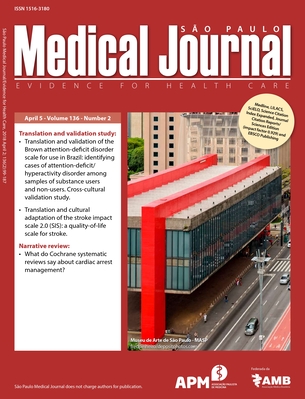Validation of single measurement of 12-hour urine excretion for estimation of sodium and potassium intake. A longitudinal study
Palavras-chave:
Electrolytes, Diet, Urine specimen collection, Validation studiesResumo
BACKGROUND: Evaluation of sodium and potassium intake can be carried out using different methods. Biological markers are able to capture intra and inter-individual variability and are used as separate measurements of consumption. The aim of this study was to test the validity of a single measurement of urinary sodium and potassium excretion as representative of habitual intake. DESIGN AND SETTING: Longitudinal study, federal university. METHODS: Food consumption data from a sample of adult university students and public servants (25 to 74 years old) were collected through 24-hour records and 12-hour urinary sodium and potassium excretion at five different times over a one-year period. The dietary data were entered into a nutritional research data software system and the sodium and potassium intakes were estimated. The variables were tested for normal distribution using the Kolmogorov-Smirnov test. One-way analysis of variance or the Kruskal-Wallis test was used to evaluate means. Correlations between measurements using Pearson or Spearman coefficients were calculated. The degree of agreement between the five measurements was given by the intraclass correlation coefficient. RESULTS: Satisfactory agreement was found between the five measurements of urinary sodium and potassium excretion over a year, with little variability in consumption. CONCLUSION: A single measurement of urinary sodium and potassium accurately estimated the usual average consumption of these electrolytes. This can be used in population-based studies.
Downloads
Referências
Paul DR, Rhodes DG, Kramer M, Baer DJ, Rumpler WV. Validation of a food frequency questionnaire by direct measurement of habitual ad libitum food intake. Am J Epidemiol. 2005;162(8):806-14. doi: 10.1093/aje/kwi279.
Willett WC. Nutritional epidemiology. 2nd ed. New York: Oxford University Press; 1998.
Pereira RA, Sichieri R. Métodos de avaliação do consumo alimentar. In: Kac G, Sichieri R, Gigante DP, editores. Epidemiologia nutricional. Rio de Janeiro: Editora Fiocruz/Atheneu; 2007. p. 181-200
Fisberg RM, Marchioni DML, Colucci ACA. Avaliação do consumo alimentar e da ingestão de nutrientes na prática clínica [Assessment of food consumption and nutrient intake in clinical practice]. Arq Bras Endocrinol Metab. 2009;53(5):617-24. doi: 10.1590/S0004-27302009000500014.
Popkin BM, Adair LS, Ng SW. Global nutrition transition and the pandemic of obesity in developing countries. Nutr Rev. 2012;70(1):3-21. doi: 10.1111/j.1753-4887.2011.00456.x.
Law MR, Frost CD, Wald NJ. By how much does dietary salt reduction lower blood pressure? I--Analysis of observational data among populations. BMJ. 1991;302(6780):811-5. PMID: 2025703.
Mill JG, Silva ABT da, Baldo MP, Molina MCB, Rodrigues SL. Correlation between sodium and potassium excretion in 24- and 12-h urine samples. Braz J Med Biol Res. 2012;45(9):799-805. PMID: 22782553.
Dietary intake data were collected and analyzed using Nutrition Data System for Research software version. Minneapolis: Nutrition Coordinating Center, University of Minnesota; 2010.
Núcleo de Estudos e Pesquisas em Alimentação. Tabela brasileira de composição de alimentos. 2a ed. Campinas: Universidade Estadual de Campinas; 2006. Available from: http://www.unicamp.br/nepa/taco/contar/taco_versao2.pdf Accessed in 2017 (Jul 6).
Willett WC, Howe GR, Kushi LH. Adjustment for total energy intake in epidemiologic studies. Am J Clin Nutr. 1997;65(4 Suppl):1220S-1228S; discussion 1229S-1231S. PMID: 9094926.
Associação Brasileira de Empresas de Pesquisa. Critério de Classificação Econômica Brasil. Available from: http://www.abep.org/criterio-brasil Accessed in 2017 (Jul 6).
Bisi Molina Mdel C, Cunha Rde S, Herkenhoff LF, Mill JG. Hipertensão arterial e consumo de sal em população urbana [Hypertension and salt intake in an urban population]. Rev Saúde Pública. 2003;37(6):743-50. PMID: 14666304.
Rodrigues SL, Souza Júnior PR, Pimentel EB, et al. Relationship between salt consumption measured by 24-h urine collection and blood pressure in the adult population of Vitória (Brazil). Braz J Med Biol Res. 2015;48(8):728-35. doi: 10.1590/1414-431X20154455.
Pereira TS, Bensenor IJ, Meléndez JG, et al. Sodium and potassium intake estimated using two methods in the Brazilian Longitudinal Study of Adult Health (ELSA-Brasil). São Paulo Med J. 2015;133(6):510-6. doi: 10.1590/1516-3180.2015.01233108.
Nakasato M. Sal e hipertensão arterial [Salt and Hypertension]. Rev Bras Hipertens. 2004;11(2):95-7. lil-394177.
Fisberg RM, Slater B, Marchioni DML, Martini LM. Inquéritos Alimentares: Métodos e bases científicas. São Paulo: Editora Manole; 2005. ISBN: 8520416381.
Tabara Y, Takahashi Y, Kumagai K, et al. Descriptive epidemiology of spot urine sodium-to-potassium ratio clarified close relationship with blood pressure level: the Nagahama study. J Hypertens. 2015;33(12):2407-13. doi: 10.1097/HJH.0000000000000734.
Pereira TS, Cade NV, Mill JG, Sichieri R, Molina MD. Use of the method of triads in the validation of sodium and potassium intake in the Brazilian Longitudinal Study of Adult Health (ELSA-Brasil). Plos One. 2016;11(12):e0169085. doi: 10.1371/journal.pone.0169085.
Lins APM, Sichieri R, Coutinho WF, et al. Alimentação saudável, escolaridade e excesso de peso entre mulheres de baixa renda. Ciênc Saúde Coletiva. 2013;18(2):357-66. doi: 10.1590/S1413-81232013000200007.
Slater B1, Marchioni DL, Fisberg RM. Estimando a prevalência da ingestão inadequada de nutrientes [Estimating prevalence of inadequate nutrient intake]. Rev Saúde Pública. 2004;38(4):599-605. doi: /S0034-89102004000400019.
Downloads
Publicado
Como Citar
Edição
Seção
Licença

Este trabalho está licenciado sob uma licença Creative Commons Attribution 4.0 International License.





